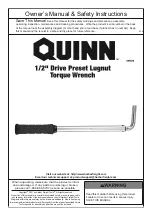
When commencing the work, the milling head should be
slowly entered until the desired depth is obtained and
then allowed to advance, always supporting the machine
with two hands.
OPERATING INSTRUCTIONS.
PRECAUTION:
The machine should always be un-
plugged before making any adjustments to the machine.
WARNING!
The actual milling operation should always
be made in the direction opposite to the milling head
rotation direction (according to Fig. 4). Advancing the
machine in the opposite direction could cause it to
rebound and lead to an accident.
1.1. Milling
1. The milling depth should be adjusted in accordance
with the previous description.
2. Switch on and place the machine over the work
piece, firmly held in place.
3. Carry out the milling operation with a uniform ad-
vancing movement.
4. On completing the milling operation, push the upper
section of the machine upwards and switch it off.
1.2. Milling with parallel stop
To install the parallel stop and with the guide rods in the
base plate
P
and held in place with the wing screws
V
according to the required measurement.
Once both wing screws
V
have been loosened, the
parallel stop can be re-adjusted using fine adjustment
S
.
Adjust the desired length with the divisions with inches
and millimeters marked on the side stop
I
.
Stop strip
S
may be used to increase the parallel stop
contact surface.
1.3. Milling with the copier bushing
Copy bushing
U
enables edges to be milled on the work-
piece in accordance with a pattern or template.
Installing the copier bushing
In order to use the copier bushing
U
, it must be installed
on the lower section of support plate
P
from above and
fixed in place with the screws.
WARNING!
It is essential to ensure correct installation
position.
1.4. Milling straight or profiled edges
When milling straight or profiled edges, without the
parallel stop, the milling head must be fitted with a guide
shaft or ball bearing (optional accessory).
The operating machine should be brought into contact
with the work-piece from the side, until the milling head
guide shaft or ball bearing is seated against the edge of
the work piece. The machine must be guided with both
hands, always perpendicular to the surface, along the
entire length of the work-piece edge. Excessive applied
pressure could damage the work-piece edge.
DUST EXTRACTION
WARNING!
Always make sure that the tool is switched
off and unplugged before fitting or removing any dust
extraction device.
Dust extraction keeps the workplace clean, prevents
dust build-up in the air and facilitates waste elimination.
These milling machines are fitted with adapter, which
can be coupled to a universal vacuum aspirator or other
dust suction device.
CAUTION:
A suction extractor should always be used
that has been designed in accordance with the applica-
ble directives in relation to dust emission when milling
wood. The flexible hoses of conventional vacuum clean-
ers fit directly onto the dust extraction nozzle.
Installing the dust suction adapter
PRECAUTION:
Before installing the suction adapter
K
,
press the fixing lever
H
so that the upper section of the
machine ascends to the upper position.
In order to install the dust suction adapter
K
, it should be
inserted in the square opening on the base plate
P
until it
fits fully into place, and then fixed using the wing screws
R
, which are located on both sides of the adapter
K
.
In order to maintain optimum chip extraction, the suction
adapter
K
should be periodically cleaned.
The aspirator should be suitable for the material being
worked.
A special aspirator must be employed in those cases
where dry harmful or carcinogenic dust is produced.
In situations where prolonged wood operations are
performed or machines are used industrially with materi-
als that produce dust that is harmful to health, the ma-
chine must be connected to a suitable external aspira-
tion device.
NOISE AND VIBRATION
This tool has been designed and made to reduce noise
to a minimum. However, in spite of this,
in certain
circumstances the maximum noise level in the place
of work could exceed 85 dBA. In this case, the op-
erator should wear ear protection.
The machine’s noise and vibration levels, measured in
compliance with EN 60745, usually reach:
Acoustic pressure = 89 dB(A)
Sound-power level = 102 dB(A)
Use ear protection!
Vibration acceleration = 4.5 m/s
2
ACCESSORIES
Accessories and their corresponding order number can
be found in our catalogues.
MAINTENANCE AND CARE
WARNING
−
Always unplug the machine before carrying
out work on it.
-
Tool inspection:
Using a blunt cutting tool leads to less
efficient work and could damage the motor, therefore
cutting tools should be sharpened or replaced as soon
as any wear is noticed.
Daily:
Clean the tool holder.
-
The milling heads must always be maintained sharp
for optimum work results.
-
Inspect the mounting screws
: Regularly inspect all
the mounting screws and ensure they are firmly tight-
ened. Should any screw be loose, tighten it immedi-
ately. Failure to do so could put you at serious risk.
-
Motor maintenance:
Take the utmost care to ensure
that the motor winding is not damaged and does not
become damp with oil or water.
-
Brush replacement:
The brushes disconnect auto-
matically and should be replaced after 150 - 200 hours
use or when they are less than 10 mm long. Have
them replaced by an Official Service Centre.






































